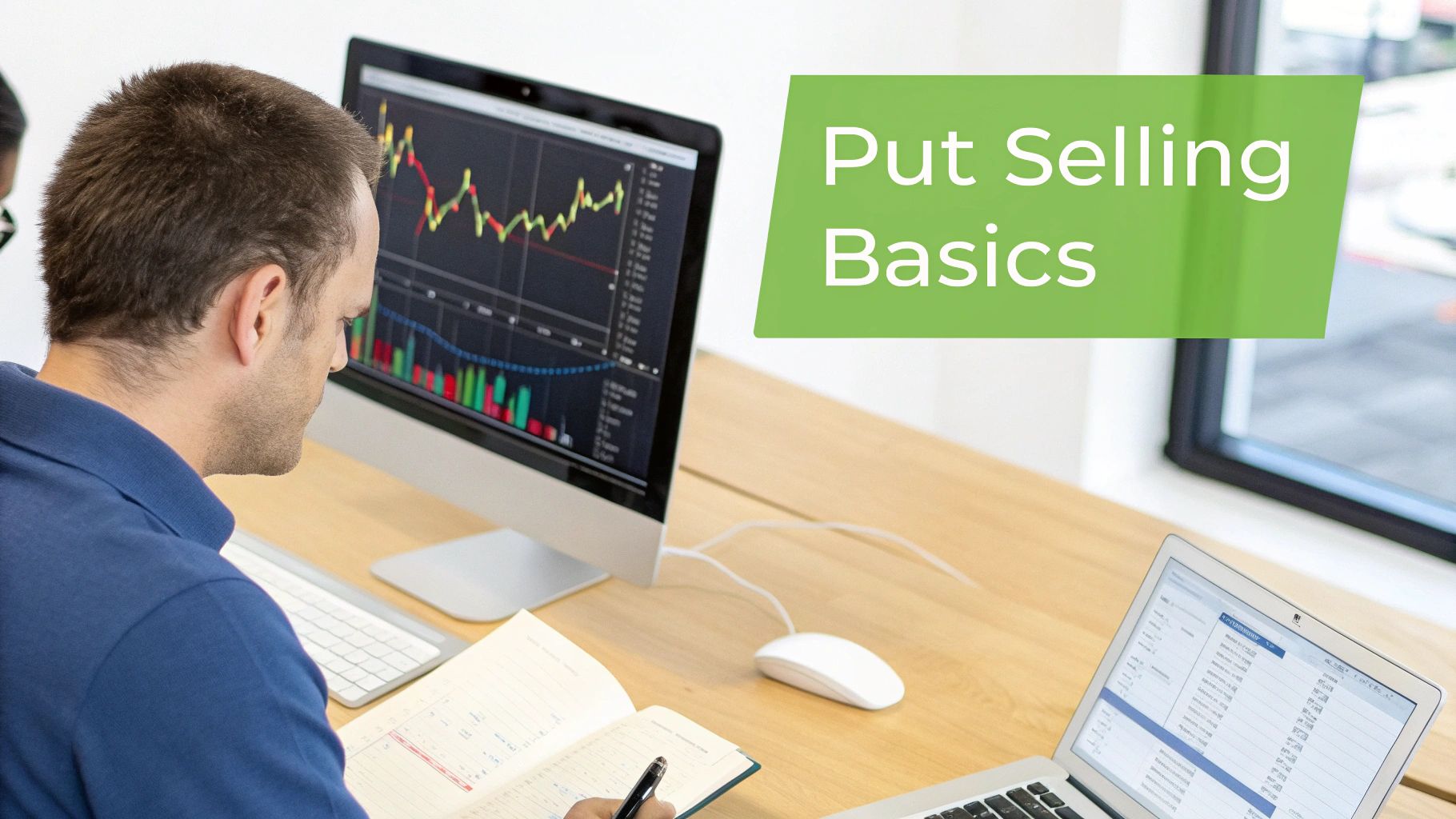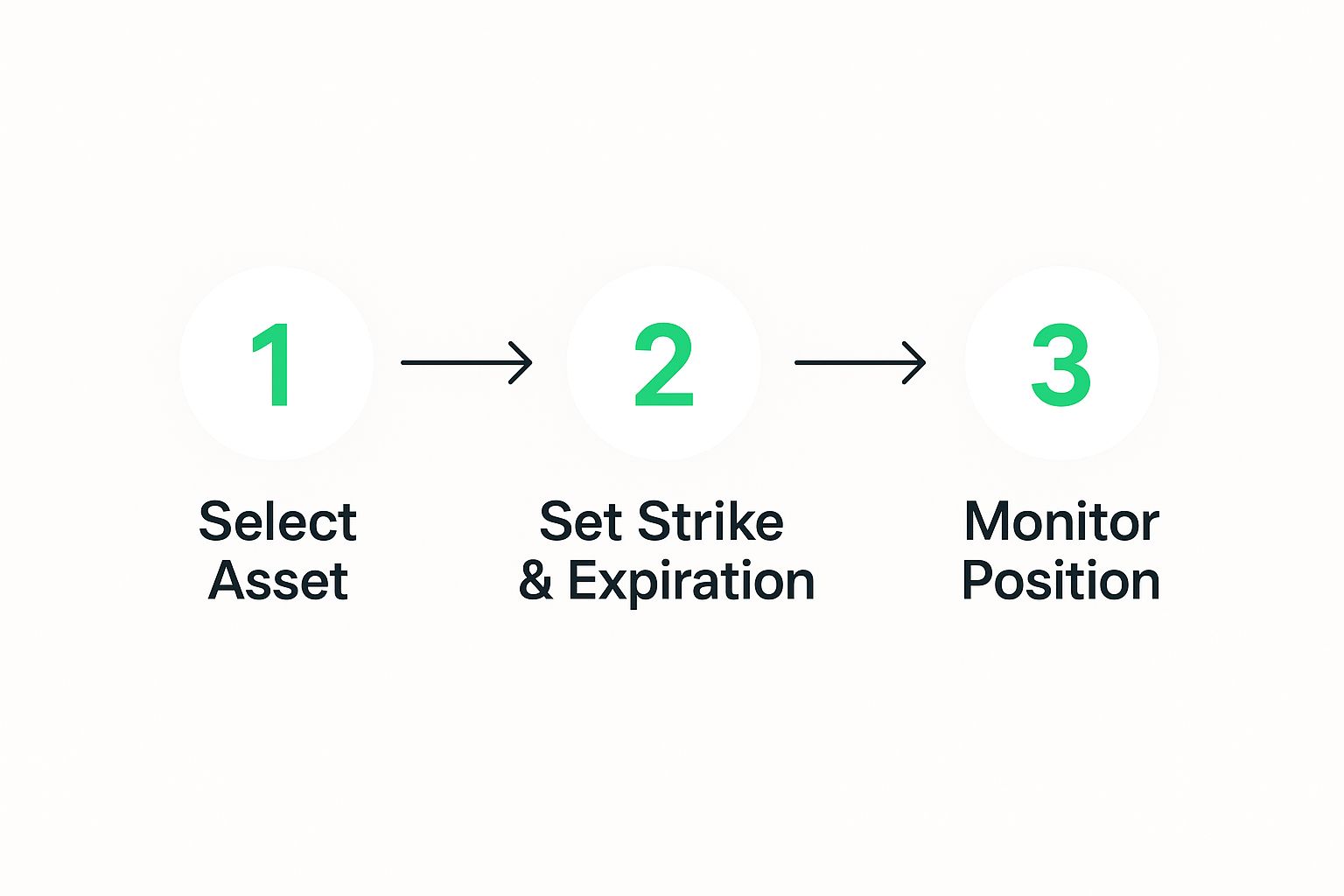Put Selling for Income A Practical Guide
If a stock moves past your strike, the option can be assigned — meaning you'll have to sell (in a call) or buy (in a put). Knowing the assignment probability ahead of time is key to managing risk.
Posted by
Related reading
A Trader's Guide to Extrinsic Value Option Profits
Unlock the power of the extrinsic value option. Learn what drives it, how to calculate it, and strategies to profit from time decay and volatility.
A Trader's Guide to the Poor Man Covered Call
Discover the poor man covered call, a capital-efficient options strategy for generating income. Learn how to set it up, manage it, and avoid common mistakes.
A Trader's Guide to Shorting a Put Option
Discover the strategy of shorting a put option. Our guide explains the mechanics, risks, and rewards of cash-secured vs. naked puts with clear examples.
When you sell a put for income, you're getting paid right now for your willingness to buy a stock you already like, but at a cheaper price later on. It's a methodical way to build consistent cash flow, turning the market's natural ups and downs into a potential revenue stream.
The Real Role of Selling Puts for Income

Forget the high-stakes, all-or-nothing gambling you see in the movies. Selling puts, when you do it right, is more like running a business than making a speculative bet. The whole idea is to collect immediate cash (the premium) in exchange for agreeing to buy a stock at a set price (the strike price) before a certain date (the expiration).
It helps to think of yourself as a landlord for the stock market. You're collecting "rent"—the option premium—for setting aside some capital. Your main "risk" is simply being asked to buy shares of a great company at a discount to where it's trading today. Honestly, that's a scenario most long-term investors would be happy with. This shift in mindset is a game-changer for success.
From Speculation to Strategy
The first step is moving past the intimidating jargon. The strike price is simply the price you agree to buy the stock at. The premium is the cash you get in your pocket, right now, for making that agreement.
Most of the time, the goal is for the option to expire worthless. This lets you keep the entire premium without ever having to buy the shares. This simple process is what transforms put selling from a guess into a repeatable method for generating returns. For a look at how other investors profit when a stock price doesn't move much, check out these strategies for generating income when stocks move sideways.
The beauty of this strategy lies in its dual purpose: it generates income while simultaneously creating strategic entry points for stocks you want in your portfolio.
This methodical approach isn't some obscure trick; it's the foundation of sophisticated financial products. In fact, private banks often build structured notes around this very concept, offering their clients yields between 8% and 15% annually. They're just doing what you can do on a larger scale.
Understanding The Core Components
To put this strategy to work, you need to know the moving parts. This isn't about memorizing complex formulas, but about understanding how each piece functions in a real trade. To help break it down, here’s a look at the key pieces of the puzzle.
Core Components of a Put Selling Transaction
| Component | Role in the Strategy | Key Takeaway |
|---|---|---|
| Strike Price | The price at which you agree to buy the shares. | This is your predetermined entry point if the stock price drops. |
| Expiration Date | The date the contract ends. | Your obligation to buy the stock is only valid until this date. |
| Premium | The cash income you receive upfront. | This is your profit if the option expires worthless. |
| Underlying Stock | The specific company stock you are trading. | Always choose a high-quality stock you wouldn't mind owning. |
| Cash Secured | The capital set aside to buy the shares if assigned. | This ensures you can fulfill your end of the deal. |
Understanding these components is the first step toward confidently selling puts. For a more detailed walkthrough, our complete guide to selling cash-secured puts covers the entire process from start to finish.
Finding the Right Stocks for Selling Puts
Successful put selling begins long before you even think about placing a trade. The real foundation of this strategy isn't about chasing the highest premium you can find. It's about finding great, fundamentally solid companies that you'd be genuinely happy to own for the long haul.
This single idea is what separates disciplined investors from speculators.
The goal is to get paid to wait to buy a fantastic company at a price you like. If you sell a put on some speculative, financially weak business just to grab a juicy premium, you're setting yourself up to be forced to buy a deteriorating asset. That’s not an investment; it's a liability waiting to happen.
Focus on Fundamentally Sound Businesses
Your first filter should always be the quality of the company. Before anything else, ask yourself: "If I had to buy 100 shares of this stock at my strike price, would I be okay holding it for the next few years?"
If the answer is anything but a confident "yes," just move on. There are plenty of other opportunities.
You should be on the lookout for companies with clear, lasting advantages.
- Strong Financials: Look for businesses with healthy balance sheets, a track record of growing revenue, and consistent profits. Steer clear of companies drowning in debt.
- Competitive Moat: Does the company have a real edge that's hard to replicate? Think of a powerful brand like Coca-Cola, a network effect like Microsoft, or some kind of proprietary tech.
- Reasonable Valuation: Don't get caught up in the hype of stocks trading at insane valuations. You want solid companies at fair prices—or even better, solid companies that have taken a temporary, undeserved dip.
The golden rule is simple: Only sell puts on stocks you actually want to own. This flips the script. The "worst-case scenario" of getting assigned the shares becomes the successful execution of your plan to acquire a quality asset at your predetermined price.
Volatility: The Double-Edged Sword
Volatility is what creates the rich premiums that make selling puts so attractive in the first place. Higher implied volatility means more potential income. But it's also a big sign that points to higher risk and bigger price swings.
This is exactly why your focus on quality is such a crucial safety net.
Imagine a blue-chip stock you love drops 10% after a slightly underwhelming earnings report. This causes its volatility to spike. For a put seller, this is a golden opportunity. You can sell a put at a strike price even further below the new, lower market price and collect a fat premium, all thanks to that temporary fear in the market.
Now, contrast that with a speculative penny stock that's always volatile because its entire future is a question mark. That high premium isn't an opportunity; it's a red flag. Selling a put on that kind of company is a pure gamble where you risk catching a falling knife.
By sticking with quality businesses, you can use temporary spikes in volatility to your advantage while seriously reducing the risk of ending up with a worthless stock.
Choosing Your Strike Price and Expiration
This is where the rubber meets the road. Picking the right strike price and expiration date is easily the most critical part of put selling for income. It's all about balancing the cash you get today with the risk you’re willing to take on tomorrow. This isn't guesswork; it's a calculated decision.
Seasoned traders don't just pull numbers out of thin air. They lean on specific metrics, and one of the most useful is the option's Delta. Think of Delta as a quick-and-dirty proxy for the probability of an option expiring in-the-money. For example, a put with a .20 Delta has roughly a 20% chance of finishing in-the-money, which also means it has an 80% chance of expiring worthless.
Finding Your Probability Sweet Spot
This probability-based thinking lets you dial in trades to match your personal risk tolerance. If you're more conservative, you might only sell puts with a very high probability of success—say, a .15 to .25 Delta. This translates to a 75-85% chance of the option expiring worthless. You'll collect less premium, but you're building in a serious margin of safety.
Feeling a bit more aggressive? You might aim for a .30 to .40 Delta to capture a higher return. The crucial thing is that you are consciously choosing your odds instead of just reacting to the market.
The core of a successful trade is finding the sweet spot where you are paid a meaningful premium for a level of risk you are genuinely comfortable with. It's about being an insurer, not a gambler.
This simple infographic lays out the basic workflow for putting this strategy into action.

As you can see, choosing the strike and expiration is the central step, but it all starts with a solid foundation of picking the right underlying stock.
Expiration Dates: The Time Factor
Your choice of an expiration date is just as important. Most income-focused traders I know gravitate toward short-term expirations, usually between 30 and 45 days out. There are a few good reasons for this:
- Faster Time Decay: An option's value bleeds away faster as it gets closer to expiration. As the seller, this time decay (known as Theta) works directly in your favor.
- More Frequent Income: Shorter cycles mean you can run the play more often, collecting premiums and compounding your returns throughout the year.
- Less Time for Things to Go Wrong: A shorter timeframe simply reduces the window for a stock to make a huge, unexpected move against your position.
Let's take a real-world example, like Tesla. Between 2023 and 2024, selling puts was a practical way to either generate income or try to get into the stock at a better price. An investor could have sold a put with a $200 strike price and pocketed a premium of around $15 per share. This instantly drops their effective breakeven purchase price to $185, creating a nice buffer against a drop in the stock.
While this approach is powerful, it's important not to confuse it with a covered call strategy, which works on the other side of the trade. For a closer look at the key differences, check out our guide on how to sell covered puts to really understand the nuances.
How to Manage Your Open Positions

Once your trade is live, the work isn't over. A "set it and forget it" mindset is a quick way to get into trouble. The key to long-term success with put selling for income is active management.
Fortunately, there are really only three ways your trade can play out. Knowing what to do in each scenario is what separates the pros from the novices.
The best-case scenario for pure income is simple: the stock price stays above your strike price. The option expires worthless, you keep 100% of the premium, and your cash collateral is freed up. Mission accomplished. You can immediately start looking for the next trade.
But the market has a mind of its own. What happens if the stock price starts flirting with your strike price as expiration gets closer? This is where your management skills really make a difference.
When a Trade Goes Against You
If the stock price dips and you've changed your mind about wanting to own the shares, you have a powerful move: you can "roll" the position. This is a single, two-part trade:
- First, you Buy to Close your current put option. This gets you out of your original obligation.
- Then, you Sell to Open a new put on the same stock, but with a later expiration date and usually a lower strike price.
This almost always results in a net credit, meaning you get paid even more premium to essentially buy yourself more time. You're paid to wait for the stock to recover.
The other path is to do nothing and let the option get assigned. You'll buy the 100 shares at the strike price you agreed to from the start.
This isn't a failure. It's just the other side of the strategy playing out exactly as planned. You collected a premium for your willingness to buy a stock you like at a discount. Now you own it.
Introducing The Wheel Strategy
Getting assigned the shares isn't the end of the road. In fact, it's the start of a popular and powerful income cycle called "The Wheel Strategy."
Once you own the 100 shares, you can immediately start selling covered calls against them. A covered call is the inverse of a cash-secured put—you get paid a premium for agreeing to sell your shares at a higher price in the future.
This move seamlessly turns one income stream (selling puts) into another (selling calls). You got paid to buy the stock, and now you're getting paid to hold it. This cycle is what transforms a simple options trade into a durable, long-term income engine for your portfolio.
Essential Risk Management for Long-Term Success

Winning at put selling for income isn't about hitting home runs on every trade. It's about playing disciplined defense. Meticulously managing your risk is what protects your capital and keeps you in the game long enough to let compounding do its work.
The most fundamental rule? Smart position sizing. Never commit more capital to a single trade than you're genuinely comfortable losing or, more accurately, using to buy the underlying stock.
A common rule of thumb I stick to is never allocating more than 2-5% of my total portfolio to a single cash-secured put position. This simple rule ensures no single trade can deal a catastrophic blow to my account.
Diversify to Survive
Beyond sizing, diversification is your next line of defense. This doesn’t just mean selling puts on different stocks across various sectors. Smart diversification also involves staggering your expiration dates.
By spreading your trades across different weeks and months, you insulate your portfolio from being overexposed to a single, nasty market event. A sudden downturn on a day when all your positions expire could be painful. But if your expirations are laddered, you have more flexibility to manage or roll positions as needed.
To achieve sustainable success with put selling, establishing comprehensive risk management frameworks is non-negotiable. It’s what turns a series of individual trades into a cohesive, resilient strategy.
The Proof Is in the Performance
This strategy's defensive nature isn't just theory; historical data backs it up. The Cboe S&P 500 PutWrite Index (WPUT), which tracks a strategy of selling at-the-money SPX puts, provides a powerful benchmark.
Historical performance shows that a systematic put-selling strategy can significantly reduce portfolio volatility and cushion against major market drawdowns compared to simply owning the underlying index.
Take the 2008 financial crisis. Research on the WPUT index showed that while the S&P 500 lost over 37%, the put-write strategy’s losses were substantially smaller.
That same study found that the maximum drawdown for the put-writing strategy from 2006 to 2018 lasted just 22 months. For the S&P 500? A grueling 52 months.
This data highlights a key benefit: put selling doesn't just generate income. It can offer a smoother ride by providing downside protection when markets get choppy. For a deeper dive into protecting your portfolio, you might find our dedicated article on options trading risk management helpful.
Answering Your Top Questions About Selling Puts
Even after you get the hang of the strategy, some questions will pop up. That’s perfectly normal. Tackling these "what-ifs" head-on is the fastest way to trade with real confidence. Let's dig into a few things that come up all the time.
The big one, of course, is what happens if the stock you sold a put on takes a nosedive.
If the stock price craters and ends up way below your strike price at expiration, you'll almost certainly be assigned the shares. This means you’re on the hook to buy them at the strike price you agreed to, which will now be much higher than where the stock is trading. You'll be looking at an immediate unrealized loss.
But this isn't a disaster—if you’ve stuck to the game plan. You chose a great company you wanted to own anyway, right? Now you just transition to the next phase. You own the shares, so you can immediately start selling covered calls against them, creating a new income stream and chipping away at your cost basis over time.
How Much Money Do I Need to Sell Puts?
Another frequent question is purely practical: How much capital does this really take? Is it only for people with huge accounts?
The answer is baked right into the name: cash-secured put. To sell a single put contract, which represents 100 shares, your broker requires you to have enough cash on hand to actually buy those shares if you have to. This isn't optional; it's a built-in safety measure.
The calculation is straightforward: (Strike Price x 100) - Premium Received.
So, if you sell a put with a $50 strike price, you need to have just under $5,000 sitting in your account as collateral for that trade. This is exactly why many new put-sellers start with high-quality, but lower-priced, stocks. It keeps the capital needed to get started much more manageable.
The cash-secured rule is one of the most important risk management features of this strategy. It physically stops you from getting over-leveraged, a classic mistake that blows up accounts in other, more complex options trades.
Is This Really "Passive" Income?
Finally, let's talk about the "passive" label. Can you really just set these trades and forget them?
Honestly, it's more semi-passive than truly passive.
It’s absolutely less demanding than being a day trader glued to a screen. But it requires more attention than just buying an S&P 500 index fund and letting it ride. The real work is upfront—doing your homework to pick solid companies and then using probability data to find the sweet spot for your strike price.
Once a trade is on, you still have to keep an eye on it, especially as expiration gets closer. You need to be prepared to make a decision: let it expire worthless, roll it out to a new date, or get ready to buy the stock. Think of it less like passive income and more like actively managing your own small, income-generating business.
Ready to stop guessing and start making data-driven decisions? Strike Price gives you the real-time probability metrics you need to sell puts with confidence. Our platform helps you find the sweet spot between premium income and safety, turning your income goals into an actionable strategy. Join thousands of investors earning consistent income at https://strikeprice.app.